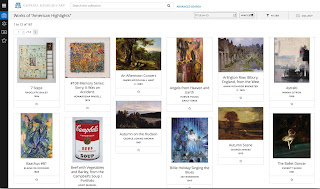 |
| Louise Blair Daura's passport from 1927 |
Imagine leaving your home, family and country
right after graduating college and moving to a bustling city halfway across the
world. It’s daunting to think about, yet for Louise Blair Daura, the idea of a
fresh start was thrilling, so she moved to Paris with her cousin and soon
decided to pursue a dream of becoming an artist. She would achieve success
during her career, but over time was overlooked and eventually forgotten about,
until now. The Georgia Museum of Art is proud to present the exhibition “Louise Blair Daura: A Virginian in Paris.”
Daura was an accomplished artist during her
life, exhibiting at the Salon d’Automne in Paris, and frequently received
praise from her friends and fellow artists for her work. Why, then, is she so
understudied today? The most likely reason is that, after about 1930, she did
not exhibit any of her works. It’s unclear why she gave up her career as an
artist, but she may have felt out of place in the Parisian art scene. Her
husband, Pierre Daura, whom she met and married in Paris, was also an artist, a
co-founder of the artists’ group Cercle et Carré. He was supportive of her
career and her art (he actually submitted her painting to the Salon), but her
figurative work was very different from what he and his friends were producing.
 |
| An untitled portrait of Louise Blair Daura's daughter, Martha, from 1930. |
Louise did continue to paint after 1930, but she
mainly produced art for herself or her friends, including portraits of her
daughter. Although she was not painting much at this time, her works were still
of high quality and precisely painted. An untitled painting of her infant
daughter shows the baby sleeping, wrapped in a floral bed sheet, with her hands
clutching the fabric and her face contorted, as if she is deep in a dream. This
skill in portrait painting is evident throughout her career, as in “Self
portrait with Mantilla.” The mantilla, a traditional Spanish lace shawl worn
over the head, is painted with precision, and Louise depicts herself in a stoic
manner. She wrote about refusing to idealize her acquaintances, or herself, for
their own pride. Both of these works can be seen in the exhibition.
 |
Louise Blair Daura, "Self-portrait with Mantilla," ca. 1929. Oil on canvas, 24 x 15 inches.
Musée d’art Hyacinthe Rigaud, Perpignan, 95.2.50 |
The exhibition is not only noteworthy because
it examines a lesser-known artist, but also because its exhibition catalogue publishes
the letters Louise Blair Daura wrote to her family in the United States, from
the time she arrived in Europe until the end of 1930. These letters give an
intimate look into her life: from her soirees with prominent artists to her travels
around France and Spain and the joyous birth of her daughter, her letters leave
the reader feeling as if they were a close friend of hers. The letters also
illustrate what life was like for an American in Paris at this time.
The exhibition is up through December 10 at
the museum, after which it will travel to the Daura Gallery at Lynchburg College, Virginia. Remaining programs include a Family Day this Saturday from 10 a.m. to noon, Museum Mix (tonight from 8
to 11 p.m.), and a Film Series on Americans in Paris, beginning November 2.
Stephanie Motter
Intern, Department of Communications









